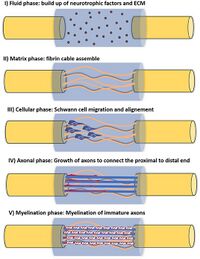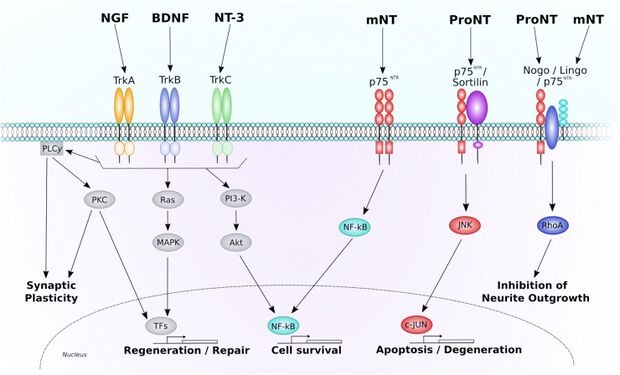Exercise and Nerve Regeneration
Original Editor - Sehriban Ozmen
Top Contributors - Sehriban Ozmen
Introduction[edit | edit source]
Various treatment methods have been developed to date to support the regeneration process of nerves, which are known to regenerate slower than other tissues in the body. These methods include nanotechnology, stem cell therapy, electrical stimulation, and others, although the level of evidence supporting their effectiveness may vary.
Exercise is only a potentially useful treatment option due to the existence of conflicting evidence on neuron regeneration (This may be because different exercise parameters were used in different studies.) This page includes studies supporting the positive effects of exercise on neuron regeneration.
Neurotrophin-Dependent Nerve Regeneration[edit | edit source]
Neurotrophins are regulative proteins that are expressed in the nervous system. Their neuronal functions are diverse, ranging from neurogenesis to programmed cell death. [1]
Brain-derived neurotrophic factor (BDNF) is a member of the neurotrophins family known for it's role in inducing plastic changes that regulate neuronal growth, excitability, and even regeneration. [2] [3]A study [4] found a correlation between serum levels of BDNF and exercise intensity in humans with spinal injury.
Neurotrophin 3 is another member of that protein family, which enhances axonal regeneration by promoting the growth of axons and has been proven to increase in level with voluntary exercise. [5][6]
Enhancement of Axon Regeneration[edit | edit source]
In rodent models of peripheral nerve injury, treadmill running has shown to be responsible of increased motor axon regeneration. [7][8][9] [10]
Moreover, the voluntary running-wheel exercise has been shown to reduce the levels of the myelin-associated glycoprotein (MAG), an axonal growth inhibitor. This may explain the mechanism behind the axonal growth effect of exercise. [11]
Exercise-Induced Neuronal Regeneration in Ischemic Stroke[edit | edit source]
A review study [12] concluded that:
- Exercise has been shown to promote axon regeneration of newborn striatonigral and corticonigral projection neurons in rats after ischemic stroke. [13]
- Constraint Induced Movement Therapy (CIMT) promotes functional recovery, associated with increased corticospinal projections from the peri-infarct motor cortex. [14]
- Exercise training may improve the regeneration of the contralesional pyramidal tract following ischemic stroke in rats. [15]
- Willed-movement therapy increases the expression levels of Growth Associated Protein 43 (GAP-43) and Neurotrophin 3 (NT-3), which is likely involved in nerve repair and regeneration in the ischemic brain in rats. [16]
References[edit | edit source]
- ↑ Nordvall G, Forsell P, Sandin J. Neurotrophin-targeted therapeutics: A gateway to cognition and more?. Drug discovery today. 2022 Oct 1;27(10):103318.
- ↑ Jin Y, Fischer I, Tessler A, Houle JD. Transplants of fibroblasts genetically modified to express BDNF promote axonal regeneration from supraspinal neurons following chronic spinal cord injury. Experimental neurology. 2002 Sep 1;177(1):265-75.
- ↑ Garraway SM, Huie JR. Spinal plasticity and behavior: BDNF-induced neuromodulation in uninjured and injured spinal cord. Neural plasticity. 2016 Oct;2016.
- ↑ LeechKristan A, George H. High-intensity locomotor exercise increases brain-derived neurotrophic factor in individuals with incomplete spinal cord injury. Journal of neurotrauma. 2017 Mar 15.
- ↑ Gómez‐Pinilla F, Ying Z, Opazo P, Roy RR, Edgerton VR. Differential regulation by exercise of BDNF and NT‐3 in rat spinal cord and skeletal muscle. European Journal of Neuroscience. 2001 Mar;13(6):1078-84.
- ↑ Ying Z, Roy RR, Edgerton VR, Gómez-Pinilla F. Voluntary exercise increases neurotrophin-3 and its receptor TrkC in the spinal cord. Brain research. 2003 Oct 10;987(1):93-9.
- ↑ Cannoy J, Crowley S, Jarratt A, Werts KL, Osborne K, Park S, English AW. Upslope treadmill exercise enhances motor axon regeneration but not functional recovery following peripheral nerve injury. Journal of Neurophysiology. 2016 Sep 1;116(3):1408-17.
- ↑ Seta H, Maki D, Kazuno A, Yamato I, Nakajima N, Soeda S, Uchiyama Y, Tamaki T. Voluntary exercise positively affects the recovery of long-nerve gap injury following tube-bridging with human skeletal muscle-derived stem cell transplantation. Journal of clinical medicine. 2018 Apr 2;7(4):67.
- ↑ Boeltz T, Ireland M, Mathis K, Nicolini J, Poplavski K, Rose SJ, Wilson E, English AW. Effects of treadmill training on functional recovery following peripheral nerve injury in rats. Journal of neurophysiology. 2013 Jun 1;109(11):2645-57.
- ↑ Wood K, Wilhelm JC, Sabatier MJ, Liu K, Gu J, English AW. Sex differences in the effectiveness of treadmill training in enhancing axon regeneration in injured peripheral nerves. Developmental neurobiology. 2012 May;72(5):688-98.
- ↑ Molteni R, Zheng JQ, Ying Z, Gómez-Pinilla F, Twiss JL. Voluntary exercise increases axonal regeneration from sensory neurons. Proceedings of the National Academy of Sciences. 2004 Jun 1;101(22):8473-8.
- ↑ Xing Y, Bai Y. A review of exercise-induced neuroplasticity in ischemic stroke: pathology and mechanisms. Molecular Neurobiology. 2020 Oct;57(10):4218-31.
- ↑ Zhang QW, Deng XX, Sun X, Xu JX, Sun FY. Exercise promotes axon regeneration of newborn striatonigral and corticonigral projection neurons in rats after ischemic stroke. PloS one. 2013 Nov 19;8(11):e80139.
- ↑ Okabe N, Himi N, Nakamura-Maruyama E, Hayashi N, Sakamoto I, Narita K, Hasegawa T, Miyamoto O. Constraint-induced movement therapy improves efficacy of task-specific training after severe cortical stroke depending on the ipsilesional corticospinal projections. Experimental neurology. 2018 Jul 1;305:108-20.
- ↑ Zhang C, Wen H, Hu X, Li C, Zeng J. Effects of physical training on pyramidal tract regeneration in hypertensive rats with focal cerebral infarction. Zhonghua yi xue za zhi. 2014 May 1;94(19):1488-93.
- ↑ Hou DR, Shadike S, Deng JF, Liu JF, Hu ZY, Zhou J, Zhou L, Liu YX. Effect of willed movement therapy on the expression of neurotrophin 3 and growth-associated protein 43 in rats with cerebral ischemia reperfusion. Nan Fang yi ke da xue xue bao= Journal of Southern Medical University. 2011 Aug 1;31(8):1401-4.








